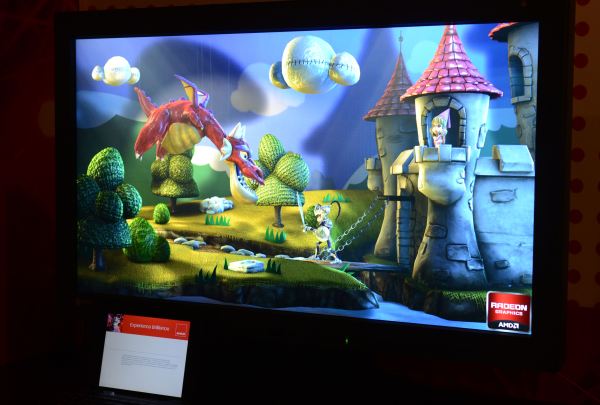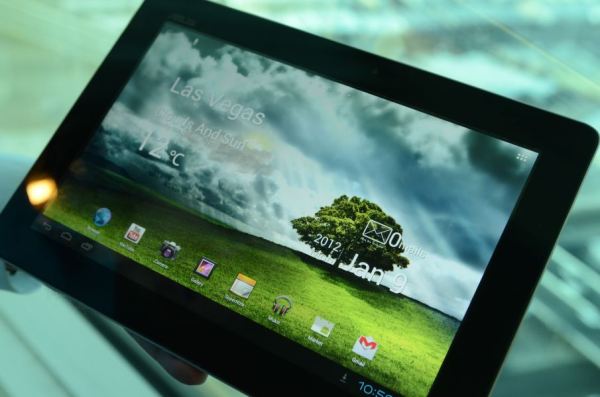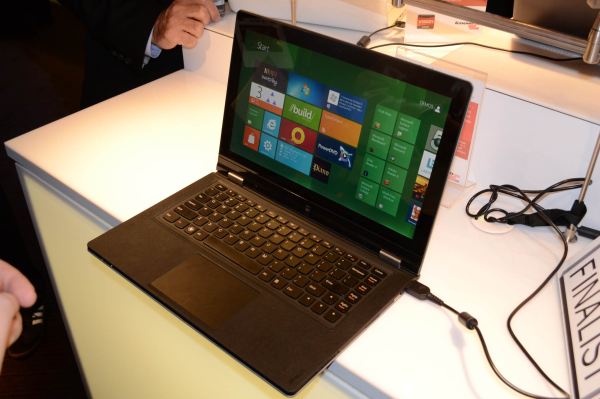
Original Link: https://www.anandtech.com/show/5437/the-best-of-ces-2012
The Best of CES 2012
by Jarred Walton on January 17, 2012 6:15 PM EST- Posted in
- Lenovo
- Asus
- CES
- Transformer Prime
- CES 2012
- Yoga 13
- Trade Shows
- 4K
Jarred’s Best of CES 2012
CES is all wrapped up and everyone is back home (presumably—there are probably a few who remained in Vegas to lose more money gamble a bit more), and one of the questions I’ve been asked repeatedly by friends and family is, “What was the coolest thing you saw at CES this year?” Now, keep in mind that I am only one person and I didn’t even see a fraction of the show floor, as there were plenty of meetings set up around Vegas, so this is just my perspective on the coolest technology trends at the show. You’ll also notice that there’s a common thread in what really impressed me, but this is a highly subjective topic so take it for what it’s worth: one man’s opinion. (And note that I am specifically not speaking for the other editors; I'm sure most of them would have a different top three.)
I Have Seen the Future, and the Future Is 4K
The most impressive thing I saw at the show for me is the 4K displays. Several places had such displays on hand, but I didn’t spend a lot of time with the various display/HDTV vendors so the first real close up encounter I had with a 4K display was at AMD’s meeting rooms. They had a 4K panel hooked up to a 7970 running an in-house demo. The demo itself wasn’t anything special, but the display… wow! I didn’t have a tape measure handy and the AMD reps I asked weren’t sure, but the panel appeared to be a 46” model (possibly 42”). I did check the native resolution, and while I’m not sure if all 4K displays will use the same resolution, this particular panel was running at 4096x2160, so it’s even wider than the current 16:9 aspect ratio panels (and closer to cinema resolutions); thankfully, with 2160 vertical pixels, I’m not sure many will complain about the loss of height.
Other than the sheer size of the display, what really stood out was the amazing clarity. The dot pitch at 4096x2160—even on a 46” display!—is slightly smaller than that of a 30” 2560x1600 display. I don’t actually need a finer dot pitch, and I had to increase the DPI of Windows in order to cope with my degrading vision (some text just looks too small to comfortably read from a couple feet away), but for videos and images I’m of the opinion that “more is always better” (provided you have the hardware to drive the resolution, obviously). Where I really see 4K being useful outside of people that love high DPI computer displays is for home theater enthusiasts that have 60” and larger displays—particularly projectors—where 1080p just doesn’t really cut it.
If you want another perspective, the consumer electronics industry is always looking for ways to get people to upgrade. When HDTV first came out, you had to choose between 720p and 1080i. A couple years later, 1080p launched and everyone “had to” upgrade. Then of course we had the 120Hz/240Hz/480Hz offerings, and 3D displays got thrown into the mix as well. Now that 1080p 120Hz displays are going for $500-$800 for 40-52” HDTVs, for a lot of people we’re at the point where our displays are good enough to last the next decade. So how do you convince people that they need to upgrade again? You come out with an even better standard. (I also suspect we’ll see a follow up to Blu-ray with native 4K support at some point in the not-too-distant future; that will also be when the content providers come up with a new “unbreakable” DRM standard that will cause a lot of grief and still get cracked within a year of launch.)
Now, I’m all for giant HDTVs, but even I would suggest that a 42” or 46” computer display sitting on your desk would be too much. Still, if I could get an IPS, PLS, or *VA panel and the weight was manageable for my desk, I’d be willing to give it a go. The only drawback I can really see is pricing; I don’t know what these displays will cost when they start showing up en masse at retail, but I wouldn’t be surprised to see five figures for a while. Then again, I remember when 60” plasma displays were going for >$20K about eight years ago, so given another decade we should see these panels in the <$1000 range (for 40-60”). However long it takes, when the price is right I know I’ll be eager to upgrade.
Looking Forward to WUXGA and QXGA Tablets
In a similar vein to the 4K displays, it looks like many tablets are getting a serious resolution bump in the next few months. When I complain regularly about the state of laptop displays (I can count the number of good laptop LCDs we saw in the last year on one hand), it gives me hope to see tablets pushing for higher quality, higher resolution panels. Amazingly enough, ASUS has announced that the Eee Prime Transformer will receive a 1920x1200 update in Q2 this year (and for the record, they’re not the only ones planning on using such a panel). Rumors suggest that the iPad 3 will go one step further and offer a QXGA (2048x1536) panel, sticking with the 4:3 aspect ratio of previous iPads—though of course Apple hasn’t officially announced anything yet—and there's even talk of some QSXGA (2560x2048) and/or QWXGA (2560x1600) tablets shipping later this year.
I had the chance to play with the upcoming Eee Prime Transformer TF700T, and I loved the increased resolution. Surprisingly, the Tegra 3 chipset appeared able to handle WUXGA quite well, though I didn’t get a chance to test any games. Gaming at WUXGA is going to really stress current SoC GPUs, however, at least if you want decent quality settings. Many desktop users—even those with high-end cards like the GTX 570/HD 6970—run at 1920x1200, albeit with significantly higher quality textures and geometry than seen in tablet games. Even so, pushing ~2MP on a tablet at decent frame rates will very likely need more memory bandwidth and faster GPUs; I expect many games will run at a lower resolution and simply scale the image to the screen size. Outside of gaming, however, higher resolutions can be very useful. Browsing the web at 1280x720 is doable, 720x1280 not so much; 1080x1920 on the other hand is wide enough for all the 1024-width websites that you won’t have to zoom out to see it. Plus, text and images in general will be improved.
What really irks me is that all of this comes in a 10.1” IPS package, exactly what I’ve been asking for in laptops for the past several years. What’s more, the price point for these is in the <$600 range, and we’re still getting 16:10 aspect ratio panels instead of being forced into 16:9. I asked several manufacturers, "How is it we're getting 16:10 aspect ratio tablets with IPS WUXGA displays, and you still can't put anything better than a low quality 1366x768 TN panel into your laptops?" Naturally, they blamed the display manufacturers and consumers for not being willing to buy better quality laptops.
There's certainly some truth to that, but it's also a matter of supply and demand; if ASUS for instance were to order a million ~13.3" 1920x1200 IPS laptop displays, I'm sure they could get prices down to <$1000 for a quality laptop. Naturally, they're worried that the laptops wouldn't sell well enough and they’d get stuck with a bunch of “too expensive” laptops. With all the $500 Best Buy laptops floating around they may be right, but I wish I could convince more people to stop settling for low quality displays in their laptops. That brings me to my final top-three device/tech that impressed me at CES.
Lenovo’s Yoga 13: Ultrabook, IPS, Windows 8, and Convertible
Last on my list of impressive showings at CES is the Lenovo Yoga 13. This is another ultrabook, and if you weren’t at the show, let me just say that Intel is pushing ultrabooks in a major way. We’ve reviewed several shipping ultrabooks, and I can guarantee there will be many more to come. Every laptop manufacturer had one (or more) on display, and Intel’s booth used probably half of their public floor space to show off ultrabooks and related technologies. So far, none of the ultrabooks we’ve reviewed have really nailed every area, but when the Yoga 13 starts shipping that might finally change.
The short summary is that the Yoga 13 sports a 1600x900 IPS touchscreen panel, and it’s beautiful to behold. How Lenovo manages to cram touchscreen and IPS, plus a folding laptop/tablet hybrid into a 17mm thick chassis is something of a mystery. Okay, perhaps it’s not that mysterious—I expect the device will carry a pretty steep price tag, but hopefully it will be worth buying. The design felt solid in the hand, the soft-touch coating on the palm rest is great, and with an Ivy Bridge CPU and SSD performance should be there as well. The only major complaint I have is that the IdeaPad Yoga 13 won’t start shipping until the Windows 8 release, and I want to test one now (or at least when Ivy Bridge officially launches).
Best of Show Summary
I didn’t intentionally set out to find a top three of CES that all shared a common theme, but it’s there nonetheless. For anyone who uses a computer or tablet, or who watches TV and movies, the one thing you always have to see is the display. Put in a great display and you can rise above the crowd; cut corners and you enter the race to the bottom that has brought about the cheap construction and poor quality that run rampant at Best Buy, Office Depot, etc.
Long term, the higher quality displays in tablets and HDTVs are eventually going to force laptops to adopt better, higher resolution displays. What's sad is that I have a 1920x1200 laptop from five years ago, and that display probably cost the manufacturer $350 (possibly less). Today's $350 displays are almost universally worse, other than having brighter LED backlighting. Meanwhile, the $1000 2.8GHz Core 2 Extreme (dual-core) CPU in the laptop is now slower than even a basic $130 Core i3-2310M in most tasks, and this formerly $4000 laptop is also slower than today's laptops that cost just $750. The price-performance ratio has shifted an order of magnitude in five years, but laptop displays continue to stagnate.
I hope we’re nearing the inflection point where consumers will start asking for better laptop displays. When all the tablets at Best Buy are WUXGA, QXGA, or even QHD/QWXGA, advertising a laptop as having a 720p panel ought to present problems for Joe Sixpack. I also hope that Windows 8 will revamp the handling of high DPI displays; Windows 7 does a bit better than Vista, and both are a big step up from XP, but I still routinely encounter applications that don’t scale with DPI settings. When such applications are written with the assumption that everything runs at 96 DPI—and worse, when they have a fixed window size—the result is text that overruns the viewable area and buttons that are unclickable. I’d guess Metro apps will all scale nicely with DPI settings, but we’ll have to see how many apps (and users) eschew Metro on desktops and laptops and stick with the familiar desktop interface.
Wrap Up
That takes care of my top three, but as I noted in the introduction I didn’t even see a fraction of the show floor. (I could also do a bottom three of CES, but that’s too easy: the taxi lines and crowds take slots one and two for me, and the pay-$12-per-day-for-lousy-Internet gets the third. But I digress.) Even with ten editors from AnandTech running around, I’m sure we missed covering a lot of cool technology and gadgets, so I’m curious to know: what do you see and/or read about at CES 2012 that impressed you most? What would you like to see us cover sooner rather than later? Let us know in the comments!






















